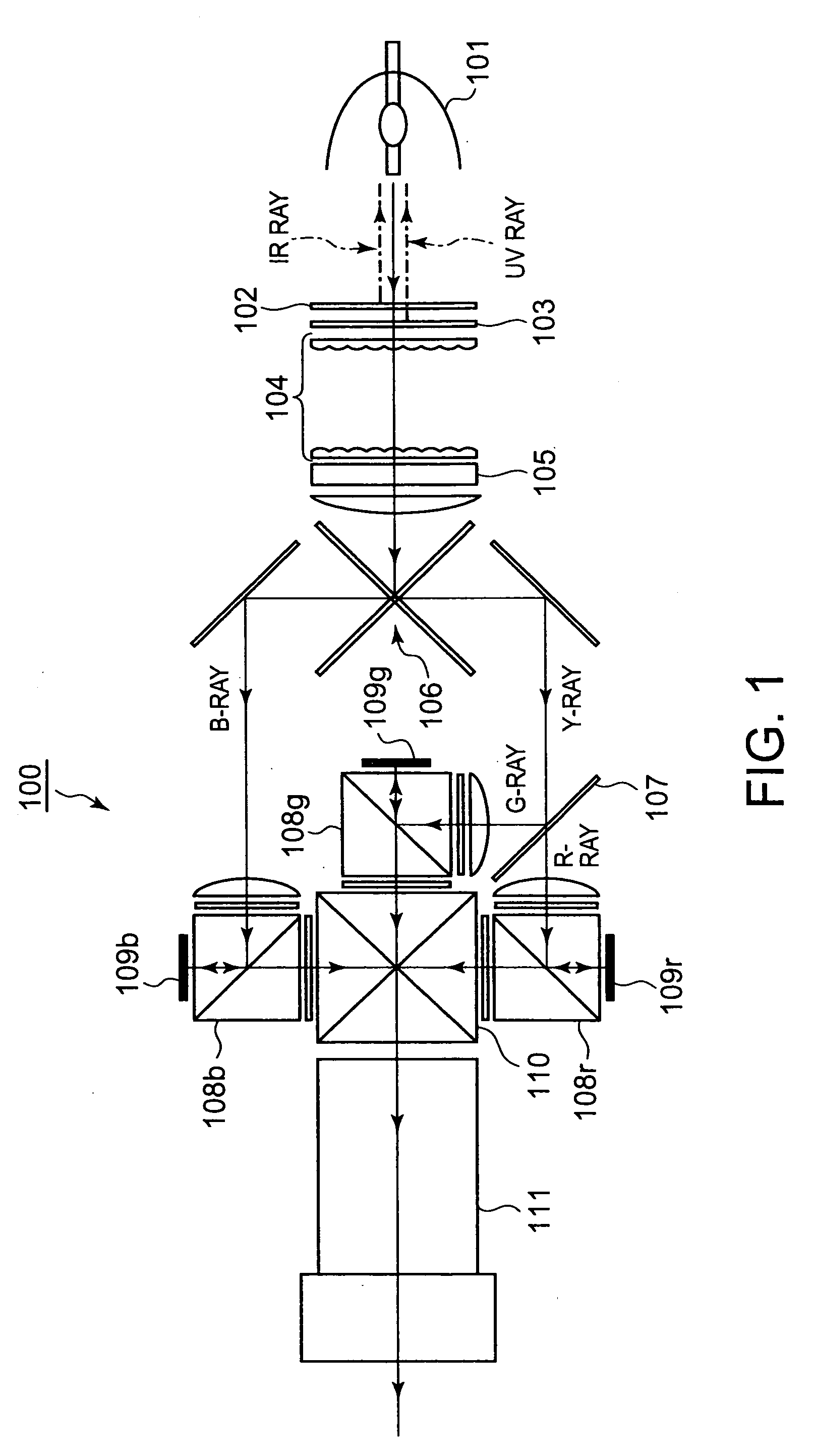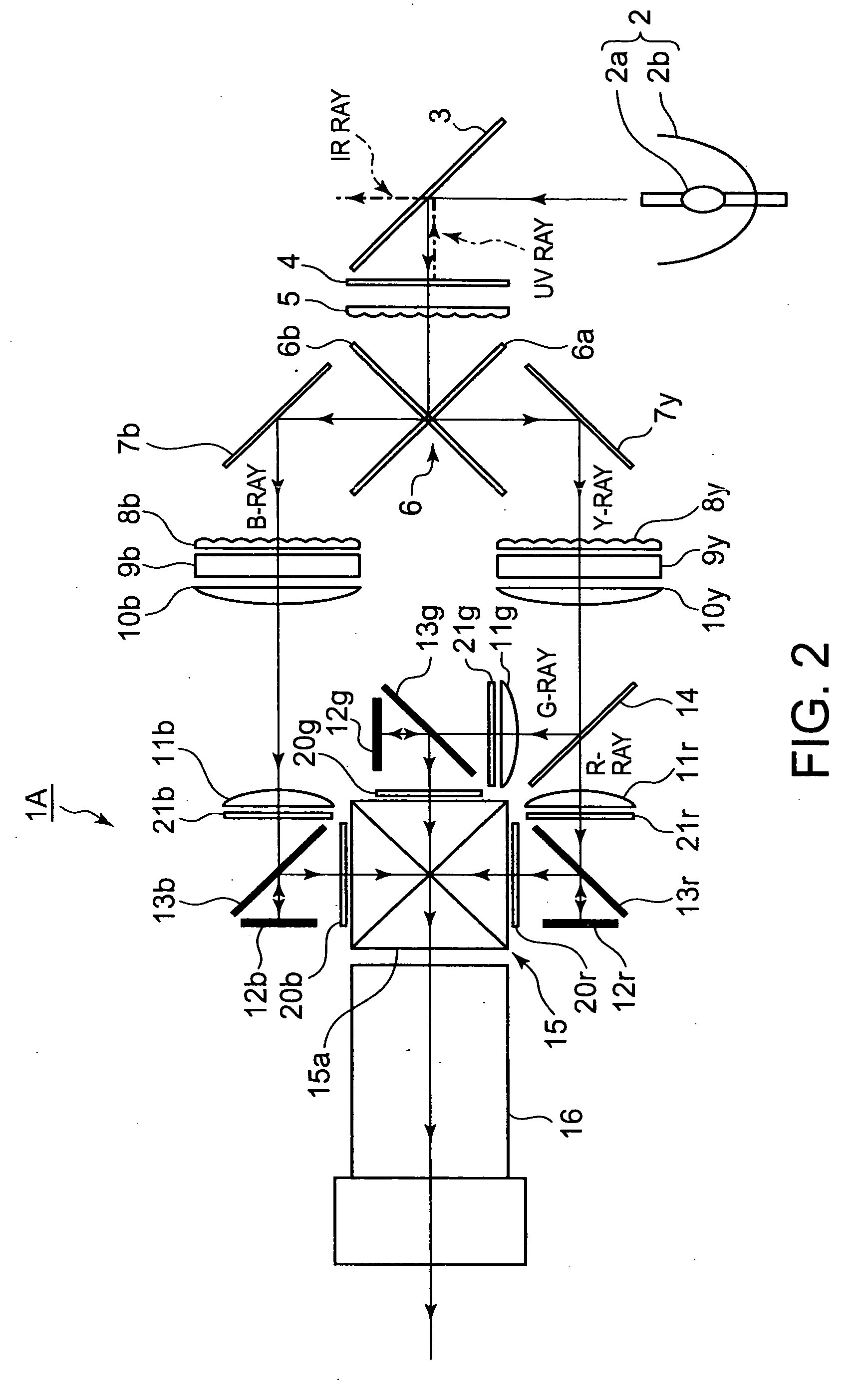Projection display apparatus
- Summary
- Abstract
- Description
- Claims
- Application Information
AI Technical Summary
Benefits of technology
Problems solved by technology
Method used
Image
Examples
first embodiment
[0051]FIG. 2 shows a schematic illustration of an optical system of a projection display apparatus 1A, as a first preferred embodiment of the present invention.
[0052]As shown in FIG. 2, the optical system of the projection display apparatus 1A is equipped with: a light source 2 having a xenon lamp 2a and a concave mirror 2b; an infrared-ray pass filter 3 that allows an infrared (RF) ray to pass therethrough while reflects the other rays; an ultraviolet-ray reflection filter 4 that reflects an ultraviolet (UV) ray while allows the other rays to pass therethrough; a fly-eye lens 5 (a first lens array) that separates an incident bundle of rays into several sub-bundles of rays; and a cross dichroic mirror 6 (a first color separator) having two dichroic mirrors 6a and 6b that separate the sub-bundles of rays into sub-bundles of rays of a blue ray (referred to as a B-ray, hereinafter) and sub-bundles of rays of a yellow ray (referred to as a Y-ray, hereinafter).
[0053]Moreover, the optical...
second embodiment
[0105]FIG. 5 shows a schematic illustration of an optical system of a projection display apparatus 1B, as a second preferred embodiment of the present invention.
[0106]The same reference numerals or signs are given to the elements of FIG. 5 that are identical or analogous to those of FIG. 2, the detailed explanation thereof being omitted for brevity.
[0107]As shown in FIG. 5, the optical system of the projection display apparatus 1B is equipped with a fly-eye lens 5b for B-ray in front of the fly-eye lens 8b and a fly-eye lens 5y for Y-ray in front of the fly-eye lens 8y, instead of the fly-eye lens 5 shown in FIG. 2.
[0108]The fly-eye lenses 5b and 8b constitute a first integrator optical system. The fly-eye lenses 5y and 8y constitute a second integrator optical system.
[0109]The light emitted from the light source 2 is incident on the cross dichroic mirror 6 (a first color separator) after infrared (RF) and ultraviolet (UV) rays are eliminated by the infrared-ray pass filter 3 and ul...
third embodiment
[0114]FIG. 6 shows a schematic illustration of an optical system of a projection display apparatus 1C, as a third preferred embodiment of the present invention.
[0115]The same reference numerals or signs are given to the elements of FIG. 6 that are identical or analogous to those of FIGS. 2 and 5, the detailed explanation thereof being omitted for brevity.
[0116]As shown in FIG. 6, the optical system of the projection display apparatus 1C is equipped with: three integrator optical systems of fly-eye lenses (5b, 8b), (5y, 8g) and (5y, 8r) for B-, G- and R-rays, respectively; three polarization converters 9b, 9g and 9y for B-, G- and R-rays, respectively; and also three condenser lenses 10b, 10g and 10r for B-, G- and R-rays, respectively.
[0117]The light emitted from the light source 2 is incident on the cross dichroic mirror 6 (a first color separator) after infrared (RF) and ultraviolet (UV) rays are eliminated by the infrared-ray pass filter 3 and ultraviolet-ray reflection filter 4,...
PUM
 Login to View More
Login to View More Abstract
Description
Claims
Application Information
 Login to View More
Login to View More - R&D
- Intellectual Property
- Life Sciences
- Materials
- Tech Scout
- Unparalleled Data Quality
- Higher Quality Content
- 60% Fewer Hallucinations
Browse by: Latest US Patents, China's latest patents, Technical Efficacy Thesaurus, Application Domain, Technology Topic, Popular Technical Reports.
© 2025 PatSnap. All rights reserved.Legal|Privacy policy|Modern Slavery Act Transparency Statement|Sitemap|About US| Contact US: help@patsnap.com



